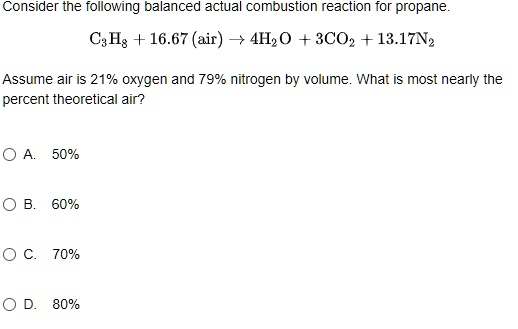Consider the following balanced actual combustion reaction for propane.

The Correct Answer and Explanation is:
The correct answer is A. 50%.
To determine the percent theoretical air, we compare the amount of air actually used in the reaction to the amount required for complete combustion. Here is how we break it down:
The balanced chemical equation shows:
C3H8+16.67 (air)→4H2O+3CO2+13.17N2\text{C}_3\text{H}_8 + 16.67\ \text{(air)} \rightarrow 4\text{H}_2\text{O} + 3\text{CO}_2 + 13.17\text{N}_2
Air is assumed to be 21 percent oxygen and 79 percent nitrogen by volume. So in 16.67 moles of air, the oxygen provided is:
16.67×0.21=3.5007 moles of O216.67 \times 0.21 = 3.5007\ \text{moles of } \text{O}_2
Now, calculate the theoretical oxygen required. In a complete combustion of propane:
- Each mole of propane yields 3 moles of CO₂ and 4 moles of H₂O.
- Each CO₂ needs 1 mole of O atoms (0.5 O₂)
- Each H₂O needs 1 O atom (0.5 O₂)
So, total oxygen needed:
3+4=7 moles of O23 + 4 = 7\ \text{moles of O}_2
Next, find how much air would be required to provide 7 moles of O₂:
70.21≈33.33 moles of air\frac{7}{0.21} \approx 33.33\ \text{moles of air}
Now, the actual air used is 16.67 moles. So, percent theoretical air used is:
(16.6733.33)×100=50%\left( \frac{16.67}{33.33} \right) \times 100 = 50\%
Thus, the percent theoretical air is 50 percent.
This problem highlights the importance of stoichiometry and air-fuel ratio calculations in combustion processes. Engineers use these calculations to optimize fuel efficiency and reduce emissions. Knowing whether combustion is complete or limited by air availability influences equipment design in engines, burners, and environmental control systems.
